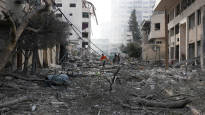A very difficult combat environment awaits the Israeli forces that have rolled into Gaza. Movement is limited in the densely built area and progress is slowed down by various traps and ambushes by Hamas fighters.
– A wise military leader tries to avoid an urban war to the last. In an urban environment, it is very difficult to advance, take over areas and keep them under control. The defender clearly has the advantage, says the lieutenant colonel Juha Mäkelä From the Defense Forces Research Institute.
So what does this combat environment look like?
Reconnaissance and combat helicopters in the air
Gaza’s airspace is very small and closed to anyone other than the Israeli Air Force. The small size means that, for example, missiles launched from fighter jets at Hamas targets are fired from outside Gaza’s airspace.
Instead of fighter jets, Israeli helicopter gunships are seen above Gaza. They look for targets and open fire when they find one. Transport helicopters are not likely to be used in Gaza because the distances are short and the risks in cramped landing sites are too great.
A combat helicopter pilot’s biggest worry is shoulder-launched anti-aircraft missiles.
Before the ground attack, Israel has tried to destroy Hamas’ weapons stockpiles, but there is still no definite information as to whether this has been completely successful.
Reconnaissance drones used by Israel look for indications of the location of Hamas fighters. Body heat, movement or, for example, an electronic trail created by communication can reveal hidden fighters.
Hamas has given individual fighting cells independent operating instructions to minimize the need for communication. Information also moves without electronic emissions with the help of cables and transmitters.
Airspace is the only combat environment that does not offer a tactical advantage to Hamas fighters.
Traps and snipers in buildings
The Israeli infantry set out to occupy the building in three groups.
The attack group does the actual room-by-room cleaning, the other group isolates the area of operation, offering the soldiers in the house peace of mind. The third group provides fire support to the attacking group if needed.
Further back, reserve forces can be expected to continue to hold the building after the assault group has moved on.
Hamas has significant bases in dozens of houses. These buildings are earned and progressing inside them is very difficult.
The Israeli forces may destroy the entire building instead of advancing through it floor by floor.
Hamas uses snipers. Their main task is to kill scouts who are ahead of the Israeli forces.
The shooter hiding in the building and the spotter looking for targets for him work in pairs. After the attack, they tried to move to another fire station without being noticed.
Rubble and roadside bombs on the streets
Israeli forces tend to move in Gaza with armored vehicles. Tanks and heavily armored bulldozers were also used.
However, movement is slow. The advance of the troops is limited, for example, by collapsed buildings on the roads and various Hamas mines.
Before the ground attack, Israel has tried to shape the street-level battlefield to its advantage. Some areas have been bombed to clear them of possible explosives.
Israeli soldiers have to get out of armored vehicles, for example, when occupying houses or clearing possible mines. In this case, the soldiers are vulnerable to Hamas snipers.
The number of soldiers needed to control houses and territories varies greatly. Basically, managing one small block in a hostile environment requires at least a company – that is, more than 100 people – strong crew.
The tunnels are left for last
An extensive network of tunnels runs under Gaza, which has been used in the past for arms smuggling and now for the movement of Hamas fighters.
Israeli forces have practiced fighting in tunnels since the 2014 Gaza war, but they are still only entered when forced to do so.
It is likely that in the early stages of the ground war, the exits of the tunnels will be blown up and the underground will be the last to go, after the other areas have been taken under control.
There is limited light, space and breathing air in tunnels. Light is not a decisive factor, as both sides have night vision equipment.
In a confined space, it is possible to use, for example, war dogs or various gases to paralyze the enemy.
Hamas fighters clearly have the tactical advantage in the tunnels, as Israel does not have accurate information about Gaza’s underground structures.
Sources: An infantryman’s guide to combat in built-up areas, US Army; Military Operations on Urbanized Terrain, US Marine Corps, interview with Lieutenant Colonel Juha Mäkelä.
